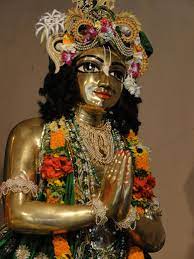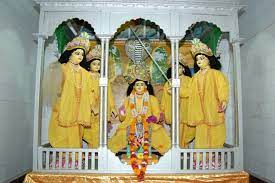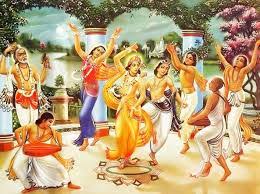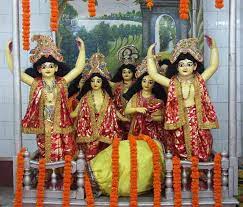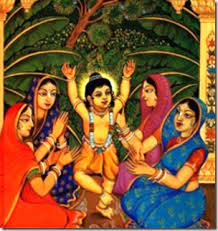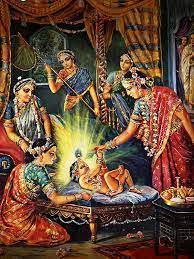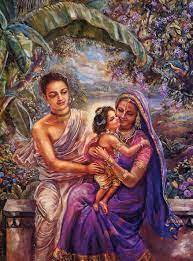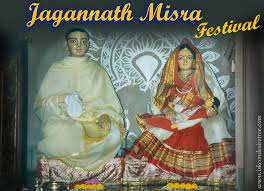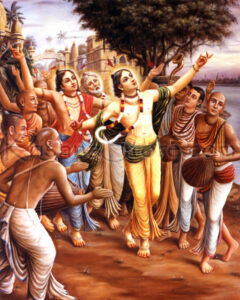Tod ay we continue our celebration of the appearance of Sri Chaitanya Mahaprabhu, the Supreme Personality of Godhead Krishna who descended in the age of Kali in the role of a devotee. He appeared on what we now call Gaura-purnima, in the evening of the full-moon day in the month of Phalguna. At the time, there was a lunar eclipse, and as was the tradition, as was recommended in scripture, Hindus immersed themselves in the Ganges and chanted the holy names. Eclipses are considered inauspicious, and to counteract the inauspiciousness, strict followers of the Vedic scriptures stand in a sacred body of water—a river, a kunda or lake, or the sea—and chant the Hare Krishna maha-mantra. So, from the very beginning, Lord Chaitanya was surrounded by the chanting of Hare Krishna, and He induced people to chant Hare Krishna more and more.
ay we continue our celebration of the appearance of Sri Chaitanya Mahaprabhu, the Supreme Personality of Godhead Krishna who descended in the age of Kali in the role of a devotee. He appeared on what we now call Gaura-purnima, in the evening of the full-moon day in the month of Phalguna. At the time, there was a lunar eclipse, and as was the tradition, as was recommended in scripture, Hindus immersed themselves in the Ganges and chanted the holy names. Eclipses are considered inauspicious, and to counteract the inauspiciousness, strict followers of the Vedic scriptures stand in a sacred body of water—a river, a kunda or lake, or the sea—and chant the Hare Krishna maha-mantra. So, from the very beginning, Lord Chaitanya was surrounded by the chanting of Hare Krishna, and He induced people to chant Hare Krishna more and more.
Advaita Acharya and Haridasa Thakura danced in ecstasy. And on the plea of giving charity to brahmans on the occasion of the eclipse, Advaita Acharya and others distributed various gifts. All the devotees were jubilant, and they danced, performed sankirtana, and gave charity. The whole world was full of auspiciousness, and everyone was filled with transcendental bliss.
nadiya-udayagiri, purnacandra gaurahari,
krpa kari’ ha-ila udaya
papa-tamah haila nasa, tri-jagatera ullasa,
jagabhari’ hari-dhvani haya
“Thus by His causeless mercy the full moon, Gaurahari, rose in the district of Nadia, which is compared to Udayagiri, where the sun first becomes visible. His rising in the sky dissipated the darkness of sinful life, and thus the three worlds became joyful and chanted the holy name of the Lord.” (Cc Adi 13.98)
When Chaitanya Mahaprabhu was a baby, sometimes He would cry and the elders would try to pacify Him in different ways, as people do when a baby cries. They would try to comfort Him, distract Him, and please Him, but nothing worked. Soon they discovered that if they chanted the holy name of Krishna, He would become peaceful and stop crying. So thereafter, whenever He cried they would chant, and He would immediately become happy. His appearance inspired chanting, and His activities thereafter inspired more chanting.
sei-kale nijalaya, uthiya advaita raya,
nrtya kare anandita-mane
haridase lana sange, hunkara-kirtana-range
kene nace, keha nahi jane
“At that time Sri Advaita Acarya Prabhu, in His own house at Santipura, was dancing in a pleasing mood. Taking Haridasa Thakura with Him, He danced and loudly chanted Hare Krsna. But why they were dancing, no one could understand.” (Cc Adi 13.99)
By His divine will, Krishna arranged for His associates from Goloka Vrindavan to come to earth to join Him in His pastimes as Sri Chaitanya Mahaprabhu. Some associates played the parts of elders, and they took birth before He did. Advaita Acharya and Haridasa Thakura were elders, and they were friends with each other. Advaita Acharya is Maha-vishnu, and Thakura Haridasa is Lord Brahma, and Lord Brahma is a disciple and direct servant of Maha-vishnu. So it is natural that they became close.
When the news spread that Sacimata had given birth to a baby boy, all sorts of respectable brahman gentlemen and ladies came with gifts and blessed the newborn child. Even the wives of the demigods came, disguised as the wives of brahmans, and presented various gifts. The day after the purnima, there was a great celebration at Jagannatha Mishra’s home. That day is observed today as the festival of Jagannatha Mishra, or the feast of Jagannatha Mishra, because to celebrate the birth of his son he received many visitors and well-wishers and gave presentations to them all. And in the end they all feasted.
We shall read from Sri Caitanya-caritamrta, Adi-lila, Chapter Thirteen, “The Advent of Lord Sri Caitanya Mahaprabhu,” beginning with the chapter summary:
“The thirteenth chapter of Sri Caitanya-caritamrta describes Lord Caitanya Mahaprabhu’s appearance. . . .
“A learned brahmana named Upendra Misra, who resided in the district of Srihatta, was the father of Jagannatha Misra, who came to Navadvipa to study under the direction of Nilambara Cakravarti and then settled there after marrying Nilambara Cakravarti’s daughter, Sacidevi. Sri Sacidevi gave birth to eight children, all daughters, who died one after another immediately after birth. After her ninth pregnancy she gave birth to a son, who was named Visvarupa. Then, in 1407 Saka Era (A.D. 1486), on the full-moon evening of the month of Phalguna, during the constellation of Simha (Leo) on the horizon, Lord Caitanya Mahaprabhu appeared as the son of Sri Sacidevi and Jagannatha Misra. After hearing of the birth of Caitanya Mahaprabhu, learned scholars and brahmanas, bringing many gifts, came to see the newly born baby. Nilambara Cakravarti, who was a great astrologer, immediately prepared a horoscope, and by astrological calculation he saw that the child was a great personality. This chapter describes the symptoms of this great personality.”
COMMENT by Giriraj Swami
We can see the resemblance between the pastimes of Lord Chaitanya and those of Lord Krishna. In Mathura, Lord Krishna’s parents, Vasudeva and Devaki, first had six sons, all of whom were killed by Kamsa. Their seventh child was Balarama, but by the arrangement of Yogamaya under Krishna’s direction, Balarama was transferred from the womb of Devaki to the womb of Rohini in Vrindavan and thus Devaki appeared to have had a miscarriage.
The eighth child was Krishna. Vasudeva did not want Kamsa to kill—or even try to kill—Krishna, and by Yogamaya’s influence all the guards in Kamsa’s prison fell asleep and all the locked doors opened. Vasudeva then carried baby Krsna across the Yamuna to Gokula. There he found that Yasoda had given birth to a baby girl, but Yasoda was so exhausted from the labor of childbirth that she didn’t know if she had given birth to a son or a daughter. Vasudeva placed baby Krishna on Yasoda’s bed and picked up her daughter, whom he carried back to Kamsa’s prison in Mathura.
As soon as the baby girl was placed in the prison room with Vasudeva and Devaki, she began to cry, and Kamsa realized that Devaki had given birth to a daughter. Earlier, on the occasion of Devaki’s wedding, Kamsa had heard a voice from the sky (akasa-vani) that said that the eighth son of Devaki would kill him. This child was a girl, but Kamsa was such a demon and was surrounded by such demonic advisors that he thought, “Let me not take any chances.” He snatched the baby to dash her on a rock and kill her as he had killed the other six children, but she slipped from his hands and flew into the sky, manifesting her form as the goddess Durga, and said, “You fool! The person who will kill you has already taken birth elsewhere.”
This is a striking statement—“the person who will kill you has already taken birth elsewhere”—because from the account so far, Krishna had taken birth in Kamsa’s prison in Mathura. Srila Visvanatha Cakravarti Thakura, as quoted by Srila Prabhupada, cites evidence from within Srimad-Bhagavatam and from other Puranas, such as the Hari-vamsa, that Yasoda actually gave birth to twins, a boy and a girl. The girl was an expansion of Yogamaya, and the boy was the original Krishna. When Vasudeva carried Vasudeva Krishna to Gokula, the Vasudeva Krishna entered into the original Krishna, and Vasudeva carried the baby girl back to Mathura.
Here in caitanya-lila we find that Sacidevi gave birth to eight daughters and that all of them died. Then finally she gave birth to a son, Visvarupa. At an early age Visvarupa left home and took sannyasa, and so for all material purposes he was dead. Srila Prabhupada said that sannyasa means civil death. The day on which Visvarupa took sannyasa is called Visvarupa-mahotsava—the same day on which Srila Prabhupada took sannyasa some four hundred years later.
In any case, it was a great occasion that Sacidevi had given birth to a boy, and all the devotees from the area, such as Advaita Acharya and his wife Sita and Srivasa Thakura and his wife, Malini, came and brought gifts and offered blessings to the new child.
TEXT 100
dekhi’ uparaga hasi’, sighra ganga-ghate asi’
anande karila ganga-snana
pana uparaga-chale, apanara mano-bale,
brahmanere dila nana dana
TRANSLATION
Seeing the lunar eclipse and laughing, both Advaita Acarya and Haridasa Thakura immediately went to the bank of the Ganges and bathed in the Ganges in great jubilation. Taking advantage of the occasion of the lunar eclipse, Advaita Acarya, by His own mental strength, distributed various types of charity to the brahmanas.
PURPORT
It is the custom of Hindus to give in charity to the poor as much as possible during the time of a lunar or solar eclipse. Advaita Acarya, therefore, taking advantage of the eclipse, distributed many varieties of charity to the brahmanas. In the Srimad-Bhagavatam there is a statement in the Tenth Canto, Third Chapter, Verse Eleven that when Krsna took His birth, Vasudeva immediately took advantage of this moment and distributed ten thousand cows to the brahmanas. It is customary among Hindus that at the time a child is born, especially a male child, the parents distribute great charity in jubilation. Advaita Acarya was actually interested in distributing charity because of Lord Caitanya’s birth at the time of the lunar eclipse. People could not understand, however, why Advaita Acarya was giving such a great variety of things in charity. He did so not because of the lunar eclipse but because of the Lord’s taking birth at that moment. He distributed charity exactly as Vasudeva did at the time of Lord Krsna’s appearance.
COMMENT
In Vedic culture householders observe all auspicious ceremonies by giving in charity. They are happy, and they know they are happy by the grace of the Lord and the devotees. And in their happiness they want to give charity and receive more blessings. When the children become adults and observe their own birth anniversaries, they also give charity. A friend of the Juhu temple who was very strict about Vedic traditions did not like that we celebrated birthdays by giving presents to the birthday boy or girl. He said, “Birthday means the birthday person gives charity.” And he didn’t like birthday cakes either. He said, “You should distribute sandesa, rasagulla, or gulabjamun. Those are real sweets.”
TEXT 101
jagat anandamaya, dekhi’ mane sa-vismaya,
tharethore kahe haridasa
tomara aichana ranga, mora mana parasanna,
dekhi—kichu karye ache bhasa
TRANSLATION
When he saw that the whole world was jubilant, Haridasa Thakura, his mind astonished, directly and indirectly expressed himself to Advaita Acarya: “Your dancing and distributing charity are very pleasing to me. I can understand that there is some special purpose in these actions.”
TEXT 102
acaryaratna, srivasa, haila mane sukhollasa
yai’ snana kaila ganga-jale
anande vihvala mana, kare hari-sankirtana
nana dana kaila mano-bale
TRANSLATION
Acaryaratna [Candrasekhara] and Srivasa Thakura were overwhelmed with joy, and immediately they went to the bank of the Ganges to take bath in the water of the Ganges. Their minds full of happiness, they chanted the Hare Krsna mantra and gave charity by mental strength.
TEXT 103
ei mata bhakta-tati, yanra yei dese sthiti,
tahan tahan pana mano-bale
nace, kare sankirtana, anande vihvala mana,
dana kare grahanera chale
TRANSLATION
In this way all the devotees, wherever they were situated, in every city and every country, danced, performed sankirtana, and gave charity by mental strength on the plea of the lunar eclipse, their minds overwhelmed with joy.
TEXT 104
brahmana-sajjana-nari, nana-dravye thali bhari’
aila sabe yautuka la-iya
yena kanca-sona-dyuti, dekhi’ balakera murti,
asirvada kare sukha pana
TRANSLATION
All sorts of respectable brahmana gentlemen and ladies, carrying plates filled with various gifts, came with their presentations. Seeing the newborn child, whose form resembled natural glaring gold, all of them with happiness offered their blessings.
TEXT 105
savitri, gauri, sarasvati, saci, rambha, arundhati
ara yata deva-narigana
nana-dravye patra bhari’, brahmanira vesa dhari’,
asi’ sabe kare darasana
TRANSLATION
Dressing themselves as the wives of brahmanas, all the celestial ladies, including the wives of Lord Brahma, Lord Siva, Lord Nrsimhadeva, King Indra, and Vasistha Muni, along with Rambha, a dancing girl of heaven, came there with varieties of gifts.
PURPORT
When Lord Caitanya Mahaprabhu was a newly born baby, He was visited by the neighboring ladies, most of whom were the wives of respectable brahmanas. In the dress of brahmanas’ wives, celestial ladies like the wives of Lord Brahma and Lord Siva also came to see the newborn child. Ordinary people saw them as neighborhood respectable brahmana ladies, but actually they were all celestial ladies dressed in that way.
COMMENT
Savitri is the wife of Lord Brahma, Gauri is the wife of Lord Siva, Sarasvati here is mentioned as the wife of Lord Nrsimhadeva, and Saci is the wife of King Indra. They all disguised themselves as brahman ladies, looking like ladies of the neighborhood, and came to offer respects to the newborn baby.
TEXT 106
antarikse deva-gana, gandharva, siddha, carana,
stuti-nrtya kare vadya-gita
nartaka, vadaka, bhata, navadvipe yara nata,
sabe asi’ nace pana prita
TRANSLATION
In outer space all the demigods, including the inhabitants of Gandharvaloka, Siddhaloka, and Caranaloka, offered their prayers and danced with musical songs and the beating of drums. Similarly, in Navadvipa city all the professional dancers, musicians, and blessers gathered together, dancing in great jubilation.
COMMENT
Bhata means “professional blessing givers.”
PURPORT
As there are professional singers, dancers, and reciters of prayers in the heavenly planets, so in India still there are professional dancers, givers of blessings, and singers, all of whom assemble together during householder ceremonies, especially marriages and birth ceremonies. These professional men earn their livelihood by taking charity on such occasions from the homes of the Hindus. Eunuchs also take advantage of such ceremonies to receive charity. That is their means of livelihood. Such men never become servants or engage themselves in agriculture or business occupations; they simply take charity from neighborhood friends to maintain themselves peacefully. The bhatas are a class of brahmanas who go to such ceremonies to offer blessings by composing poems with references to the Vedic scriptures.
COMMENT
Vedic culture is very beautiful and highly elevated. Even now in India the culture is there, though not as much as before. When I was in Bombay last December, I visited an old friend, a very nice devotee, who is related to the Birlas. And it just so happened that there was an engagement ceremony in the Birla family, from the mother’s side. Sri Brijratan Mohatta had married Seth R. D. Birla’s daughter, and their son’s daughter was about to be engaged. So, I went to the engagement reception, and there I met a bhajana singer named Purushottam Das Jalota. When I first went to India, in 1970, he was very popular. He sang bhajanas in aristocratic Hindus’ homes and gave lessons in voice and harmonium. As he grew older, his son, as happens, became his apprentice and also began to sing bhajanas and play harmonium. So, we invited his son, who was relatively unknown then, to perform at our auditorium in Juhu.
At the engagement reception Purushottam approached me. He is about eighty-seven now and was wearing a traditional Hindu jacket and cap. After we spoke for some time, he made an indication and said, “Anup is there,” and he tried to call him, but because his voice was not so loud, his son Anup could not hear him. I said, “That’s all right. I’ll go and see him.” I guess the father wanted me to bless and encourage his son.
Anup remembered his first performance in the ISKCON auditorium. I didn’t usually attend such performances, but somehow that evening, near the end of the performance I had felt drawn into the auditorium. I had found a seat toward the back and sat down. The whole atmosphere had been surcharged—I can’t explain it—and he had sung with such devotion that his words and voice had entered people’s minds and hearts. It had been a very special performance, and the devotees had recorded it and produced an audio cassette that they would distribute on sankirtana—and it had become a hit. Many people would come and ask for Anup Jalota’s tape.
When I met Anup at the reception, he remembered that night. He said that when he had entered the auditorium he had not been sure whether or not he would pursue a career as a singer. He had prayed, “Lord Krishna, I am Yours. Whatever You want You can do. If You want me to pursue this career, You can make me a success. If You don’t, that’s all right—whatever You wish.” And he remarked that it was because of his performance in the ISKCON auditorium and the recording of it that he had become a success as a singer. (I knew that was the case, but I didn’t want to say it. But he also knew it, and he said it—and it was true.)
That culture and that mood are becoming rare—that mood of devotion, of surrender, of dependence on the Lord—but they are still there.
Now we return to the description of Jagannatha Mishra’s festival:
TEXT 107
keba ase keba yaya, keba nace keba gaya,
sambhalite nare kara bola
khandileka duhkha-soka, pramoda-purita loka,
misra haila anande vihvala
TRANSLATION
No one could understand who was coming and who was going, who was dancing and who was singing. Nor could they understand one another’s language. Yet all unhappiness and lamentation were immediately dissipated, and people became all-jubilant. Thus Jagannatha Misra was also overwhelmed with joy.
TEXT 108
acaryaratna, srivasa, jagannatha-misra-pasa,
asi’ tanre kare savadhana
karaila jatakarma, ye achila vidhi-dharma,
tabe misra kare nana dana
TRANSLATION
Candrasekhara Acarya and Srivasa Thakura both came to Jagannatha Misra and drew his attention in various ways. They performed the ritualistic ceremonies prescribed at the time of birth according to religious principles. Jagannatha Misra also gave varieties of charity.
TEXT 109
yautuka paila yata, ghare va achila kata,
saba dhana vipre dila dana
yata nartaka, gayana, bhata, akincana jana,
dhana diya kaila sabara mana
TRANSLATION
Whatever riches Jagannatha Misra collected in the form of gifts and presentations, and whatever he had in his house, he distributed among the brahmanas, professional singers, dancers, bhatas, and the poor. He honored them all by giving them riches in charity.
TEXT 110
srivasera brahmani, nama tanra ‘malini’,
acaryaratnera patni-sange
sindura, haridra, taila, kha-i, kala, narikela,
diya puje narigana range
TRANSLATION
The wife of Srivasa Thakura, whose name was Malini, accompanied by the wife of Candrasekhara [Acaryaratna] and other ladies, came there in great happiness to worship the baby with paraphernalia such as vermilion, turmeric, oil, fused rice, bananas, and coconuts.
PURPORT
Vermilion, kha-i (fused rice), bananas, coconuts, and turmeric mixed with oil are all auspicious gifts for such a ceremony. As there is puffed rice, so there is another preparation of rice called kha-i, or fused rice, which, along with bananas, is taken as a very auspicious presentation. Also, turmeric mixed with oil and vermilion makes an auspicious ointment that is smeared over the body of a newborn baby or a person who is going to marry. These are all auspicious activities in family affairs. We see that five hundred years ago at the birth of Lord Caitanya Mahaprabhu all these ceremonies were performed rigidly, but at present such ritualistic performances hardly ever take place. Generally a pregnant mother is sent to the hospital, and as soon as her child is born he is washed with an antiseptic, and this concludes everything.
COMMENT
The parents and other elders did whatever they could to ensure the wellbeing of the child in all respects. They knew that the purpose of the child’s life was to serve and please God and that the child’s success in all respects depended on the mercy of God and His devotees.
TEXT 111
advaita-acarya-bharya, jagat-pujita arya,
nama tanra ‘sita thakurani’
acaryera ajna pana, gela upahara lana,
dekhite balaka-siromani
TRANSLATION
One day shortly after Lord Caitanya Mahaprabhu was born, Advaita Acarya’s wife, Sitadevi, who is worshipable by the whole world, took her husband’s permission and went to see that topmost child with all kinds of gifts and presentations
PURPORT
It appears that Advaita Acarya had two different houses, one at Santipura and one at Navadvipa. When Lord Caitanya Mahaprabhu was born, Advaita Acarya was residing not at His Navadvipa house but at His Santipura house. Therefore, as formerly explained (text 99), from Advaita’s old paternal house (nijalaya) in Santipura, Sita came to Navadvipa to present gifts to the newborn child, Caitanya Mahaprabhu.
TEXT 112
suvarnera kadi-ba-uli, rajatamudra-pasuli,
suvarnera angada, kankana
du-bahute divya sankha, rajatera malabanka,|
svarna-mudrara nana haragana
TRANSLATION
She brought different kinds of golden ornaments, including armlets, necklaces, anklets, and bangles for the hands.
TEXT 113
vyaghra-nakha hema-jadi, kati-pattasutra-dori
hasta-padera yata abharana
citra-varna patta-sadi, buni photo pattapadi,
svarna-raupya-mudra bahu-dhana
TRANSLATION
There were also tiger nails set in gold, waist decorations of silk and lace, ornaments for the hands and legs, nicely printed silken saris, and a child’s garment, also made of silk. Many other riches, including gold and silver coins, were also presented to the child.
PURPORT
From the gifts presented by Sita Thakurani, Advaita Acarya’s wife, it appears that Advaita Acarya was at that time a very rich man. Although brahmanas are not the rich men of society, Advaita Acarya, being the leader of the brahmanas in Santipura, was considerably well-to-do. Therefore He presented many ornaments to the baby, Lord Caitanya Mahaprabhu. But Kamalakanta Visvasa’s asking for three hundred rupees from the King of Jagannatha Puri, Maharaja Prataparudra, on the plea that Advaita Acarya was in debt for that amount, indicates that such a rich man, who could present many valuable ornaments, saris, etc., thought it difficult to repay three hundred rupees. Therefore the value of a rupee at that time was many thousands of times what it is now. At present, no one feels difficulty over a debt of three hundred rupees, nor can an ordinary man accumulate such valuable ornaments to present to a friend’s son. Probably the value of three hundred rupees at that time was equal to the present value of thirty thousand rupees.
COMMENT
The value of the thirty thousand rupees mentioned in the purport is now probably three hundred thousand rupees or more.
TEXT 114–116
Riding in a palanquin covered with cloth and accompanied by maidservants, Sita Thakurani came to the house of Jagannatha Misra, bringing with her many auspicious articles such as fresh grass, paddy, gorocana, turmeric, kunkuma and sandalwood. All these presentations filled a large basket.
When Sita Thakurani came to the house of Sacidevi, bringing with her many kinds of eatables, dresses, and other gifts, she was astonished to see the newborn child, for she appreciated that except for a difference in color, the child was directly Krsna of Gokula Himself.
Seeing the transcendental bodily effulgence of the child, each of His nicely constructed limbs full of auspicious signs and resembling a form of gold, Sita Thakurani was very pleased, and because of her maternal affection, she felt as if her heart were melting.
TEXT 117
durva, dhanya, dila sirse, kaila bahu asise,
cirajivi hao dui bhai
dakini-sankhini haite, sanka upajila cite,
dare nama thuila ‘nimai’
TRANSLATION
She blessed the newborn child by placing fresh grass and paddy on His head and saying, “May You be blessed with a long duration of life.” But being afraid of ghosts and witches, she gave the child the name Nimai.
PURPORT
Dakini and Sankhini are two companions of Lord Siva and his wife who are supposed to be extremely inauspicious, having been born of ghostly life. It is believed that such inauspicious living creatures cannot go near a nima tree. At least medically it is accepted that nima wood is extremely antiseptic, and formerly it was customary to have a nima tree in front of one’s house. On very large roads in India, especially in Uttar Pradesh, there are hundreds and thousands of nima trees. Nima wood is so antiseptic that the Ayurvedic science uses it to cure leprosy. Medical scientists have extracted the active principle of the nima tree, which is called margosic acid. Nima is used for many purposes, especially to brush the teeth. In Indian villages ninety percent of the people use nima twigs for this purpose. Because of all the antiseptic effects of the nima tree and because Lord Caitanya was born beneath a nima tree, Sita Thakurani gave the Lord the name Nimai. Later in His youth He was celebrated as Nimai Pandita, and in the neighborhood villages He was called by that name, although His real name was Visvambhara.
COMMENT
Visvambhara means “one who maintains the universe.” Sri Caitanya-caritamrta (Adi 9.7) describes how Lord Chaitanya appreciated that name:
prabhu kahe, ami ‘visvambhara’ nama dhari
nama sarthaka haya, yadi preme visva bhari
“Lord Caitanya thought, ‘My name is Visvambhara, “one who maintains the entire universe.” Its meaning will be actualized if I can fill the whole universe with love of Godhead.’ ”
In my youth, my dentist was a family friend who had served in India during World War II, and as he worked on my teeth he would tell me about his experiences in India as a dentist in the America army. He remarked that he had always seen the native Indians squatting along the roads brushing their teeth with twigs. As part of his work, he would treat Indians too, and he said that when he looked into their mouths he was astonished to see the most beautiful white teeth he had ever seen—without any cavities. And all these people did was brush their teeth with twigs!
TEXT 118
putramata-snanadine, dila vastra vibhusane,
putra-saha misrere sammani’
saci-misrera puja lana, manete harisa hana,
ghare aila sita thakurani
TRANSLATION
On the day the mother and son bathed and left the maternity home, Sita Thakurani gave them all kinds of ornaments and garments and then also honored Jagannatha Misra. Then Sita Thakurani, being honored by mother Sacidevi and Jagannatha Misra, was greatly happy within her mind, and thus she returned home.
PURPORT
On the fifth day from the birth of a child, as also on the ninth day, the mother bathes either in the Ganges or in another sacred place. This is called niskramana, or the ceremony of coming out of the maternity home. Nowadays the maternity home is a hospital, but formerly in every respectable house one room was set aside as a maternity home where children would take birth, and on the ninth day after the birth of a child the mother would come into the regular rooms in the ceremony called niskramana. Of the ten purificatory processes, niskramana is one. Formerly, especially in Bengal, the higher castes observed four months after the birth of a child as a quarantine. At the end of the fourth month, the mother could see the sun rise. Later the higher castes, namely the brahmanas, ksatriyas, and vaisyas, observed only twenty-one days as a quarantine, whereas the sudras had to observe thirty days. For the sections of society known as kartabhaja and satima, the mother of the child was immediately purified after the quarantine by the throwing of hari-nuta, small pieces of sweetmeat, in sankirtana. Sacidevi and Jagannatha Misra, with the newborn child, were honored by Sita Thakurani. Similarly, while Sita Thakurani was returning home, she was also honored by Sacidevi and Jagannatha Mishra. That was the system in respectable families of Bengal.
COMMENT
Srila Prabhupada was also born in a separate house, under a jackfruit tree, that belonged to his mother’s parents. Last November His Holiness Radhanath Swami and I visited that place in south Calcutta, saw the tree under which Srila Prabhupada had been born, and visited the Radha-Krishna temple that Prabhupada’s mother had frequented, imagining how she and the rest of the family must have prayed for the welfare of the new child, whom they named Abhay Charan, “one who is fearless, having taken shelter at Lord Krishna’s lotus feet.”
TEXT 119
aiche saci-jagannatha, putra pana laksminatha,
purna ha-ila sakala vanchita
dhana-dhanye bhare ghara, lokamanya kalevara,
dine dine haya anandita
TRANSLATION
In this way mother Sacidevi and Jagannatha Misra, having obtained a son who was the husband of the goddess of fortune, had all their desires fulfilled. Their house was always filled with riches and grains. As they saw the beloved body of Sri Caitanya Mahaprabhu, day after day their pleasure increased.
PURPORT
Lord Sri Caitanya Mahaprabhu is the Supreme Personality of Godhead. Therefore everyone offered respects to Him. Even the denizens of heaven used to come in the dress of ordinary men to offer their respect to the Lord. His father and mother, Jagannatha Misra and Sacidevi, seeing the honor of their transcendental son, also became very pleased within their hearts.
TEXT 120
misra—vaisnava, santa, alampata, suddha, danta,
dhana-bhoge nahi abhimana
putrera prabhave yata, dhana asi’ mile, tata,
visnu-prite dvije dena dana
TRANSLATION
Jagannatha Misra was an ideal Vaisnava. He was peaceful, restrained in sense gratification, pure, and controlled. Therefore he had no desire to enjoy material opulence. Whatever money came because of the influence of his transcendental son, he gave it in charity to the brahmanas for the satisfaction of Visnu.
TEXT 121
lagna gani’ harsamati, nilambara cakravarti,
gupte kichu kahila misrere
mahapurusera cihna, lagne ange bhinna bhinna,
dekhi,—ei taribe samsare
TRANSLATION
After calculating the birth moment of Lord Caitanya Mahaprabhu, Nilambara Cakravarti privately said to Jagannatha Misra that he saw all the different symptoms of a great personality in both the body and birth moment of the child. Thus he understood that in the future this child would deliver all the three worlds.
COMMENT
Although Sri Chaitanya Mahaprabhu had all the signs of a great personality and was in fact the Supreme Personality of Godhead, His father, Jagannatha Misra, considered Him to be his son.
As a child, Lord Chaitanya was quite naughty, and Jagannatha Mishra would often chide Him and instruct Him in proper behavior. One night, Jagannatha Mishra had a dream in which a brahman angrily told him, “You do not know anything about your son. Because you think Him to be your son, you rebuke and chastise Him.” Jagannatha Mishra replied, “He may be a demigod, a mystic yogi, or a great saint, but whatever He may be, I know Him only as my son, and it is my duty to teach Him religion and morality. Otherwise, how will He learn? Even if He is Lord Narayana Himself, it is the duty of the father to instruct the son.” Even in his dreams, Jagannatha Mishra was absorbed in the mellow of pure parental affection.
In His youth, Lord Chaitanya asked an astrologer to tell Him who He had been in His past life. Through calculation and meditation, the astrologer saw the brilliantly effulgent form of the Lord as the resting place of the Vaikuntha planets. Struck with wonder, he said, “In Your previous birth You were the shelter of all creation, the Supreme Personality of Godhead, full of all opulence. And You are the same Personality of Godhead now.” Lord Chaitanya smiled and said, “I think you do not know very clearly what I was, for I know that in My previous birth I was a cowherd boy. I was born in a family of cowherd men and gave protection to the cows and calves, and because of these pious activities, I have now become the son of a brahman.”
TEXT 122
aiche prabhu saci-ghare, krpaya kaila avatare,
yei iha karaye sravana
gaura-prabhu dayamaya, tanre hayena sadaya,
sei paya tanhara carana
TRANSLATION
In this way Lord Caitanya Mahaprabhu, out of His causeless mercy, made His advent in the house of Sacidevi. Lord Caitanya is very merciful to anyone who hears this narration of His birth, and thus such a person attains the lotus feet of the Lord.
TEXT 123
paiya manusa janma, ye na sune gaura-guna,
hena janma tara vyartha haila
paiya amrtadhuni, piye visa-garta-pani,
janmiya se kene nahi maila
TRANSLATION
Anyone who attains a human body but does not take to the cult of Sri Caitanya Mahaprabhu is baffled in his opportunity. Amrtadhuni is a flowing river of the nectar of devotional service. If after getting a human body one drinks the water in a poison pit of material happiness instead of the water of such a river, it would be better for him not to have lived, but to have died long ago.
PURPORT
In this connection Srimat Prabodhananda Sarasvati has composed the following verses in his Caitanya-candramrta (37, 36, 34):
acaitanyam idam visvam yadi caitanyam isvaram
na viduh sarva-sastra-jna hy api bhramyanti te janah
“This material world is without Krsna consciousness. Lord Caitanya Mahaprabhu is Krsna consciousness personified. Therefore if a very learned scholar or scientist does not understand Sri Caitanya Mahaprabhu, certainly he is wandering uselessly in this world.”
prasarita-maha-prema-piyusa-rasa-sagare
caitanya-candre prakate yo dino dina eva sah
“A person who does not take advantage of the nectar of devotional service overflowing during the presence of Sri Caitanya Mahaprabhu’s cult is certainly the poorest of the poor.”
avatirne gaura-candre vistirne prema-sagare
suprakasita-ratnaughe yo dino dina eva sah
“The advent of Lord Caitanya Mahaprabhu is just like an expanding ocean of nectar. One who does not collect the valuable jewels within this ocean is certainly the poorest of the poor.”
Similarly, Srimad-Bhagavatam (2.3.19, 20, 23) states:
sva-vid-varahostra-kharaih
samstutah purusah pasuh
na yat-karna-pathopeto
jatu nama gadagrajah
bile batorukrama-vikraman ye
na srnvatah karna-pute narasya
jihvasati dardurikeva suta
na copagayaty urugaya-gathah
jivan chavo bhagavatanghri-renum
na jatu martyo ’bhilabheta yas tu
sri-visnu-padya manujas tulasyah
svasan chavo yas tu na veda gandham
“A person who has no connection with Krsna consciousness may be a very great personality in so-called human society, but actually he is no better than a great animal. Such big animals are generally praised by other animals like dogs, hogs, camels, and asses. A person who does not lend his aural reception to hearing about the Supreme Personality of Godhead must be considered to have earholes like holes in a field. Although that person has a tongue, it is like the tongue of a frog, which unnecessarily creates a disturbance by croaking, inviting the snake of death. Similarly, a person who neither takes advantage of the dust of the lotus feet of great devotees nor smells the tulasi leaves offered to the lotus feet of the Lord must be considered dead even though he is supposedly working.”
Similarly, Srimad-Bhagavatam 10.1.4 states:
nivrtta-tarsair upagiyamanad
bhavausadhac chrotra-mano-’bhiramat
ka uttamasloka-gunanuvadat
puman virajyeta vina pasu-ghnat
“Who but the animal-killer or the killer of the soul will not care to hear glorification of the Supreme Personality of Godhead? Such glorification is enjoyed by persons liberated from the contamination of this material world.”
Similarly, Srimad-Bhagavatam 3.23.56 says, na tirtha-pada-sevayai jivann api mrto hi sah: “Although a person is apparently living, if he does not serve the lotus feet of great devotees he is to be considered a dead body.”
COMMENT
By the mercy of Sri Chaitanya Mahaprabhu and that of His devotees, especially Srila Prabhupada, we have been given real life—the chance to live in Krishna consciousness
TEXT 124
sri-caitanya-nityananda, acarya advaitacandra,
svarupa-rupa-raghunathadasa
inha-sabara sri-carana, sire vandi nija-dhana,
janma-lila gaila krsnadasa
TRANSLATION
Taking on my head as my own property the lotus feet of Sri Caitanya Mahaprabhu, Nityananda Prabhu, Acarya Advaitacandra, Svarupa Damodara, Rupa Gosvami, and Raghunatha dasa Gosvami, I, Krsnadasa Kaviraja Gosvami, have thus described the advent of Sri Caitanya Mahaprabhu.
[A talk by Giriraj Swami on Jagannatha Mishra’s festival, March 22, 2008, Dallas]

















 By Mayapur Sasi dasa
By Mayapur Sasi dasa
